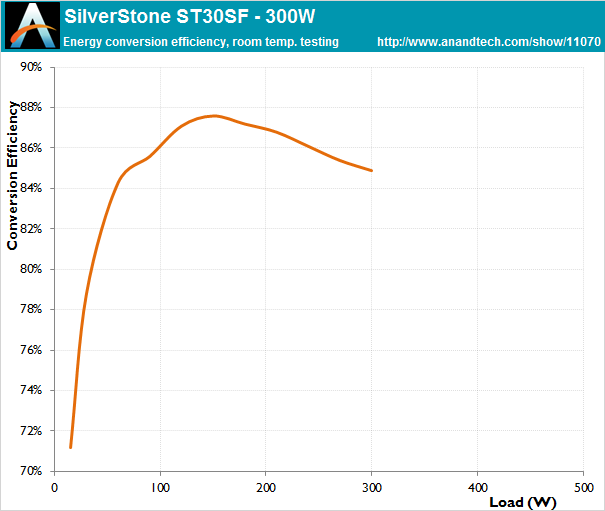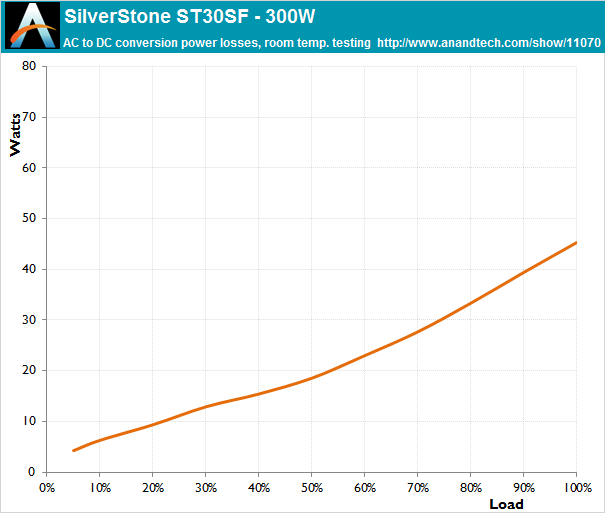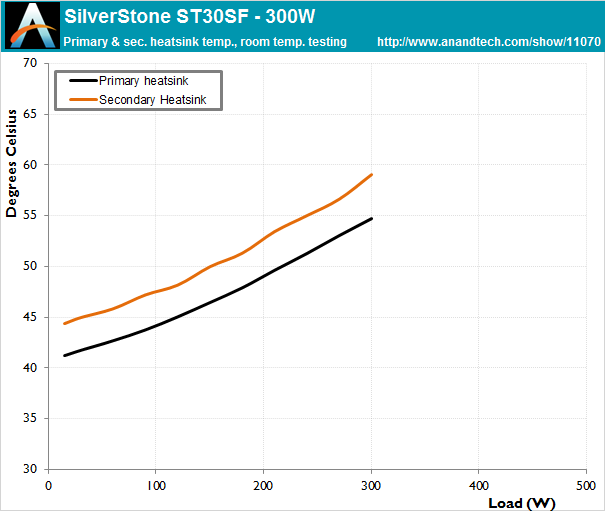The Silverstone ST30SF & ST45SF SFX Power Supply Review
by E. Fylladitakis on January 26, 2017 9:00 AM EST- Posted in
- Cases/Cooling/PSUs
- PSUs
- 80Plus Bronze
- SilverStone
- SFX
- ST30SF
- ST45SF
Cold Test Results
For the testing of PSUs, we are using high precision electronic loads with a maximum power draw of 2700 Watts, a Rigol DS5042M 40 MHz oscilloscope, an Extech 380803 power analyzer, two high precision UNI-T UT-325 digital thermometers, an Extech HD600 SPL meter, a self-designed hotbox and various other bits and parts. For a thorough explanation of our testing methodology and more details on our equipment, please refer to our How We Test PSUs - 2014 Pipeline post.

| Efficiency |
Despite having only an 80Plus Bronze efficiency certification and that we were testing them with a room temperature lower than the standard 25 °C that the testing guidelines dictate, both units failed to achieve even that level of efficiency with a 230VAC input. The maximum efficiency of both units at 50% load is just shy of the 88% figure that they had to reach in order to comply with the certification standards. The platform received its certification rating with an input of 110VAC though, where the efficiency standard dictates a minimum of 85% efficiency at 50% load, not 88%. Even though all switching PSUs are less efficient with an input of 110VAC, it is very much likely that the platform does meet the qualification ratings, even if only barely. Regardless, both the ST30SF and the ST45SF display relatively stable energy conversion efficiency, with an average of 86.1% and 86.3% respectively (within their nominal operational range - 20% to 100% of the unit's capacity). The efficiency plummets at lower loads, diving all the way down to almost 70% at just 5% load.

| Power Losses |
These two PSUs are an excellent opportunity to showcase how picking an oversized PSU can lead to inferior overall performance. With both units based on the same platform but with a severely different power range, the ST45SF is at a great disadvantage with loads lower than 80-90 Watts, whereas the ST30SF come within its nominal loading range with a load of just 60 Watts. What this means is that the ST30SF is significantly more efficient than the ST45SF with a load of about 80-90 Watts or below. By looking at the graphs, we can see that the ST45SF generates significantly greater losses at very low loads due to inefficient operation, making it hotter and louder than its much less powerful sibling. This is an excellent example of how an unnecessarily oversized PSU can be actually detrimental.

| Intake & Exhaust Air Temperature |

| Heatsink Temperature |
From the sound pressure level graphs, we can see that both units reach about the same maximum noise output when operating in room temperature, although the 450W model does so with an output that is 50% greater than the 300W model. The operating temperatures of the ST45SF are however a little higher, hinting a slightly laxer cooling profile.

| Sound Pressure Level |










30 Comments
View All Comments
jabber - Thursday, January 26, 2017 - link
PSU is a key component. Plus if you buy a quality one, it may well be the only part that carries over to the next build.Achaios - Wednesday, February 1, 2017 - link
Speaking of it, the only component that has carried itself over to my present build from my first 2008 gaming PC build, is the DVD-ROM drive. It comes very handy with games such as GTAV and the 6 DVD's that came with it.I admit though that if I knew what I know now about PC's, it is possible that I would have kept the original Cooler Master PSU that came with my Cooler Master case, provided that it wouldn't have failed.
Samus - Thursday, January 26, 2017 - link
I personally love PSU reviews. It's interesting to see where corners can be cut to shave costs, and how different manufactures market and how OEM's approach different designs.jabber - Friday, January 27, 2017 - link
I think on my 5820K build back in May I spent more time looking up the PSU than any other part.Samus - Saturday, January 28, 2017 - link
I believe it. I've had a PC Power and Cooling 750 Quad since 2008 go through a PC I kept for 3 years, a mining rig, and now back to a SLI gaming pc. It has had an incredibly hard life being run at 90% load 24/7 on the mining rig for almost 4 year so non-stop, and now it's driving a Xeon workstation with two 980's...It's quiet, has been reliable, and it wasn't even that expensive ($120?) it's 80 Plus but I don't know what tier.
PSU is something everyone should pay attention too. A crappy one could actually result in an unstable PC, especially under load, and a quality one will save money over the long run.
ZipFreed - Tuesday, January 31, 2017 - link
This, so much this. I've seen so many builds over the years both from friends in RL and all over the web with high-end parts and absolutely garbage PSU choices. If you're going to spend $500+ on a CPU you can absolutely afford the +$50 necessary for a quality PSU.I was finally able to build my own rig when I was about 10 years old after always using hand me down parts. I did a ton of research and a quality PSU was something I consistently saw mentioned. Used PCP&C Silencer and have continued to use high-quality PSU's and am currently pushing 30. In that time I've never had a single PSU related failure and have peace of mind knowing my hardware is covered if something happens.
I've been using mainly Seasonic the past 5-6+ years and generally re-use both my PSU, Case and Watercooling loop with 2-3+ different CPU/GPU/Mobo combos before refreshing everything every 18-24 months and repurposing the old stuff. First SS unit is almost 8 years old and it's ran a heavily overclocked system from day 1 and never skipped a beat and is still going strong.
PSU is the lifeblood of your machine, why skimp out?
just4U - Tuesday, January 31, 2017 - link
many on this site likely care simply because they build their own PCs and build for others... I always pay particular interest to which oem is making the unit..and what the reviewers thoughts are on the overall quality.caten - Wednesday, February 1, 2017 - link
I care. +1 for PSU reviews, especially for the more mainstream wattage sizes. I have a mITX system so another +1 for SFX.NZLion - Thursday, January 26, 2017 - link
These seem like very low wattages for modern power supplies. Is my perspective skewed? Is this likely sufficient for the sort of system that would normally use a PSU in the SFX formfactor?For reference, I have a system that uses an SFX PSU, but I went for a 600W unit and even that I felt was a worryingly small margin over the requirements of my system.
flgt - Thursday, January 26, 2017 - link
I would have thought most SFX power supplies are used in small, lower performance machines. Also most likely integrated graphics. So I'm thinking average system power demands of around 100W. As other posters have noted, it's not a good idea to install oversized power supplies as the increased static power kills efficiency at light loads.